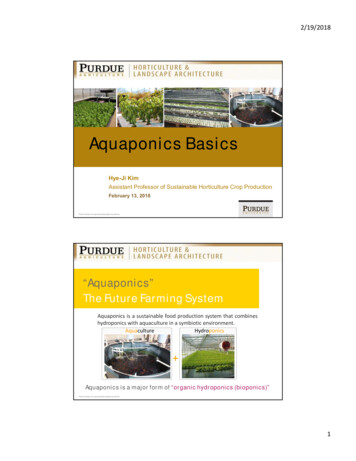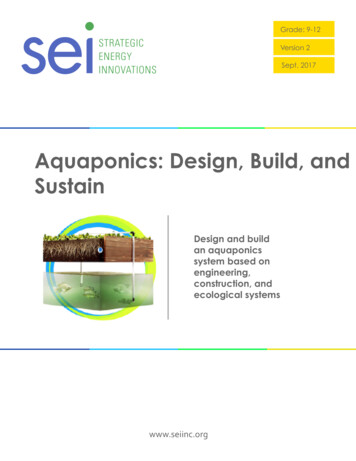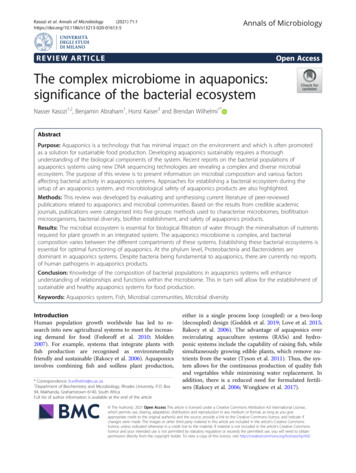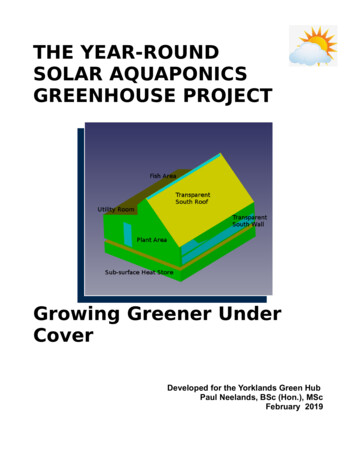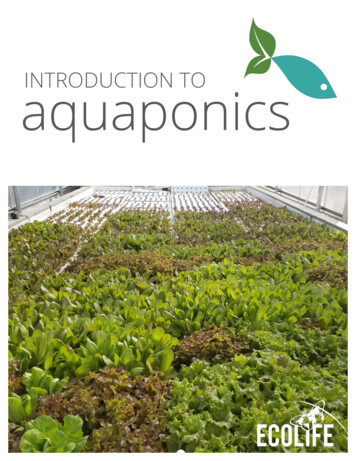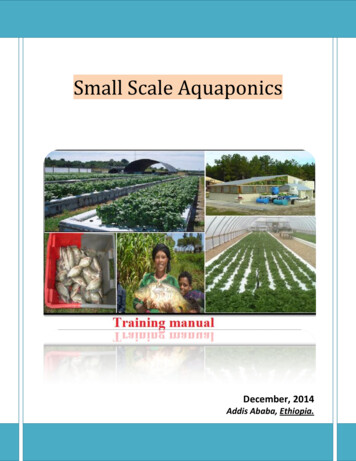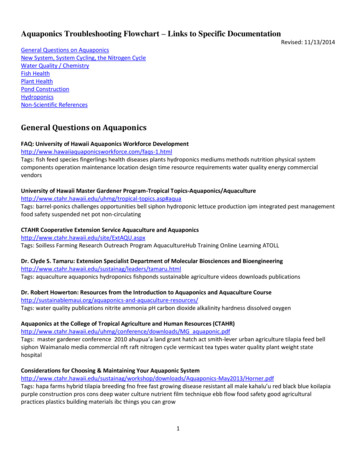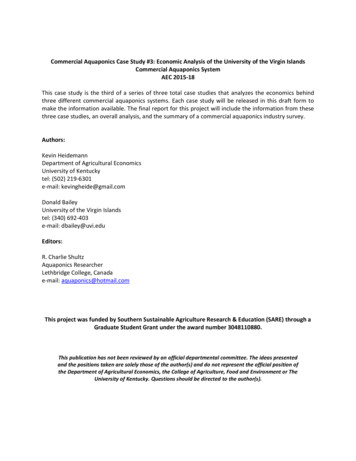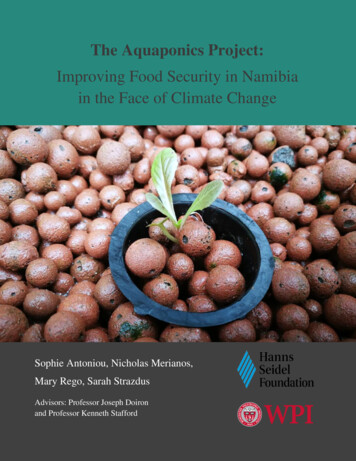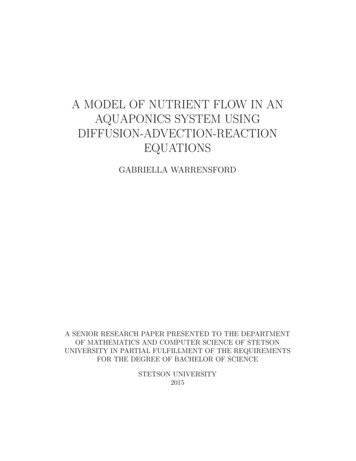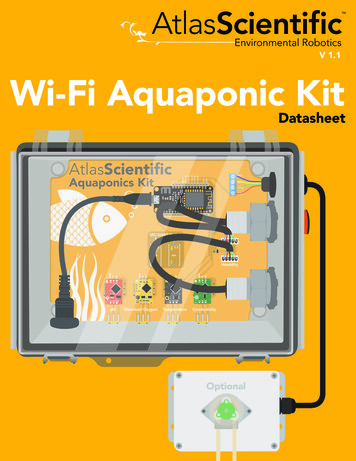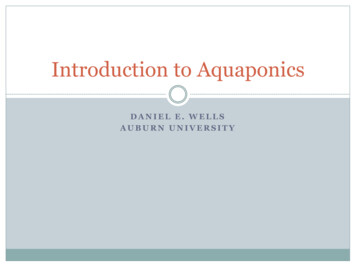
Transcription
Introduction to AquaponicsDANIEL E. WELLSAUBURN UNIVERSITY
Definition Aquaponics – Aquaculture Hydroponics Basic idea is: Multiple uses of water Recover as much value from inputs as possible Minimize negative environmental impact Sustainable system
Who can/should do aquaponics? Backyard hobbyists Community groups? Commercial scale? Fish producers who want to diversify Usually shouldn’t go the other way
The AU approach We are trying to design and operate a commercial-scale system. Primary process is tilapia production using biofloctechnology. De-coupled system Multiple vegetable species (other plants as well)
What are we growing in aquaponics? What are you growing in an aquaponic system? At least 3 things:Aquatic animals (usually fish)2. Plants (high value)3. Bacteria1.
Fish Various types of fish can be used, but we are typicallylimited in our selection.Need a warm water species (typically).1.1.Rainbow trout (13-15 C; 55-60 F); Nile tilapia (21-29 C; 7085 F)2. Needs to be able to survive well in RAS.1.Confinement, high levels of nutrients in water, etc.3. Needs to eat a high protein diet.1.Protein N
Nile Tilapia Work nicely in most aquaponic systems Tilapia are tough fish. Tolerate wide range of pHTolerate high concentration of nitratesVigorous eatersEat primary feed and partially digested feed Adaptive to many environments. Value?
Plants Need to grow high-value plants. Species that are normally grown in s With some exceptions possibly
Bacteria Two major types of bacteria are crucial to success inaquaponics: Nitrosomonas spp. Nitrobacter spp. Both types must be present to effectively transformwaste into fertilizer.
How does it work? The science behind aquaponics relies on anunderstanding of the nitrogen cycle. In natural systems, nitrogen is cycled from one formto another to another, and so on Aquaponics utilizes this natural cycle to produceprotein and vegetables in the same system.
The Basic Idea1.Fish convert protein (organic N) into ammoniacalN excreted in feces, urine, and through gills.2. Bacteria convert ammoniacal-N to nitrate-N.3. Plants remove nitrate-N from water.
System Design Options Continual recirculation (circular design) Fish – plants – fish – plants De-coupled system (linear design) Fish – plants – plants – plants
System schematics Primary process is fish production in anyaquaponic system. Either the fish are being intensively produced forsale, utilized as fertilizer factories, or both. Re-tasking the fish waste leads to the secondary andtertiary processes.
High-protein, soy-based feedand water are the primaryinputs into the system. Track the water movementthrough the system. Nutrients (N) move withwater through the system. Multi-use water andnutrients.
University of the Virgin Islands (UVI) System
Nitrogen cycle Nitrogen is present in multiple forms in our environment. N2 gas in atmosphere (70%) Organic N (amino acids, proteins, DNA, etc.) Ammoniacal N – Ammonium (NH4 ) and ammonia (NH3) Nitrites (NO2-) Nitrates (NO3-)
Bacteria are our friends Bacteria are the workforce behind aquaponics Will not work at all without bacteria We want to grow the right types and set up the rightconditions for them to be happy Nitrosomonas spp. Nitrobacter spp.
Biofilter A biofilter is material that allows bacteria to colonizeand do the work we want them to do. In this case, nitrification. Many different types of biofilters are available. Shredded PVC (surface area) – 3D printed media –bead filters - flocculants within fish productionwater
Biofilter For biofilters to be most effective, we need constantagitation of the water. The biofilter can be within the water column of theRAS or outside it.
Biofilter Low-cost system that we use at AU: Bio-floctechnology (BFT) Water column in RAS is the biofilter.
Biofloc Technology (BFT) Bacteria flocculate together, when present in veryhigh concentrations, to form “bioflocs” Bioflocs are suspended in the water column throughconstant aeration (bubbling) Bacteria in bioflocs carry out nitrification!
So, solids in the system are constantly agitated viaaeration. Solids solid waste, bioflocs, partially digestedwaste, etc. Tilapia will eat primary feed and bioflocs. Increases FCR (Feed Conversion Ratio)!
What do we do with the solids? We must remove the solids on a regular basis. Can repurpose solids –1.Organic soil amendment2.Horticultural substrate amendment3.Anaerobic digestion – biogas4.Fermentation – lactic acid production Liquid fraction nitrates
Conical Clarifier:Passive clarification
Clarifiedwater ispumpedfromclarifier Busing anirrigationpumpA primary clarifier with baffleB secondary clarifier without baffleC solids removal sump
Active Filtration
Solids are Bad! Whether we use water culture or soilless culture,we can’t have too many solids in our nutrientsolution.
Solids are Bad! Whether we use water culture or soilless culture,we can’t have too many solids in our nutrientsolution.
What do we have to work with?
What happens to N when you feed fish?
NITRIFICATIONAmmonia (NH3): Ammonium (NH4)TANNitrosomonasNitrite(NO2-)NH4 NitrobacterNitrate(NO3-)pHNO3H HH
DENITRIFICATIONNitrate(NO3-)Nitrogen Gas(N2-)H H HpHH2O
Nitrification If we want to maximize our efficiency it is in our bestinterest to maximize nitrification Much debate in aquaponics world about this At AU, we have taken the commercial foodproduction approach to the problem Some other institutions have attempted primarily tomaintain balance in the system
Nitrification Nitrosomonas spp. Nitrobacter spp. Most efficient (happiest?) at pH 7.5 – 8.5 Plants are happiest at 5.8 – 6.5 What pH do we shoot for? Nitrification will drive pH down!
Finding the right pH in our system At this point, AU aquaponics system runs at pH 6.2– 6.8. Plants are happy (at least pH-wise) Avg. daily nitrate concentrations 200 – 600 ppm 200 – 600 ppm NO3-N 45 – 135 ppm N
Recommended Nutrient ConcentrationsAquaponics vs HydroponicsNutrientAquaponics (mg/L)Hydroponics (mg/L)Calcium10.0 – 82.0150.0Magnesium0.7 – 13.050.0Potassium0.3 – 192.0150.0Nitrate0.4 – 82.0115.0Phosphate0.4 – 15.050.0Sulfate0.1 – 23.0113.0Iron0.03 - .5
We may get more nitrification at higher pH Increase plant production! Ultimately, we want to design a system in which allof our nitrates and water are being utilized withinthe system (i.e. minimal waste) How do we increase pH?
Our water has low alkalinity. Add lime to the water. Hydrated lime – Ca(OH)2 (very caustic, use withcaution) Currently, we add lime weekly. We would need to add lime daily to maintain pH 7
Problems with high pH? A major problem with high pH in fish production isthe higher presence of “un-ionized” ammonia NH3 NH4 much less toxic to fish [NH3] 5 mg / L dead fish
In theory: higher pH more bacteria morenitrification less TAN What about other nutrients? We supplement potassium (K), calcium (Ca), andIron (Fe) Muriate of potash (K), hydrated lime (Ca), chelatediron (Sprint 330)
What do we have to work with?
AU Approach Focus on commercialization of technology.Dutch Bucket Culture / Beit Alpha Cucumbers Increase nitrification Decouple fish and plant production. Spread nitrate-rich water to large population ofplants
No-Clog Emitters(Bowsmith)
AU Approach Focus on commercialization of technology.Dutch Bucket Culture /BeitAlpha Cucumbers Increasenitrification Decouple fish and plant production. Spread nitrate-rich water to large population ofplants
High-protein, soy-based feedand water are the primaryinputs into the system. Track the water movementthrough the system. Nutrients (N) move withwater through the system. Multi-use water andnutrients.
FishCucumbersTomatoesPeppers
rs
BasilLettuceAlgaeFishTomatoesCucumbers
Why decouple? Pesticides, even organic options, are often highlytoxic to fish. Maximizing water use efficiency does not mean thesame thing as recirculating water over and over. Diseases?
Is Aquaponics commercially viable? The technology works. Proven in several, differentsystems. Can you make ? Is it safe?
The Current Situation Intensive aquaculture (RAS) is not profitable, inmany cases. Low cost of imported fishExpensive to process “You make money on the plants” So, why aquaponics?
The science behind aquaponics relies on an understanding of the nitrogen cycle. In natural systems, nitrogen is cycled from one form to another to another, and so on Aquaponics utilizes this natural cycle to produce pr
